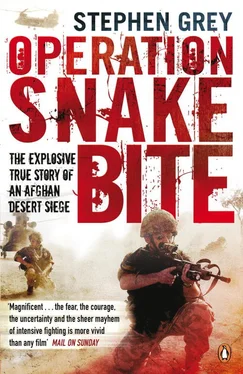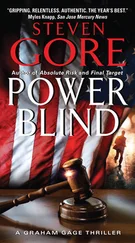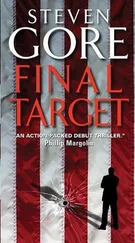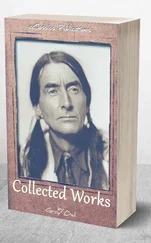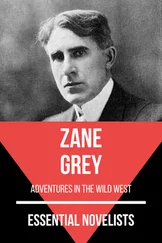The Taliban had known for days now that an offensive was about to start. They were bullish. ‘Our lines are so strong that the foreigners will never break them,’ one commander told an Afghan reporter. ‘The foreigners say they are going to launch a major operation in Musa Qala. We are ready for that. In Musa Qala alone, we have 2,050 armed fighters. It will be very easy for us to resist the attack.’ [18] Aziz Ahmad Tassal, ‘Musa Qala: The Shape of Things to Come?’ Afghan Recovery Report No. 275, IWPR, 27 November 2007. Available at: http://iwpr.net/?p=arr&s=f&o=340961&apcstate=henparr .
US special forces were already watching the town and trying to track the movement of the Taliban’s key leaders. Two days earlier the first blow had been struck. A bomb hit a compound in the town, and the US announced they had killed a senior commander responsible for the kidnap of an Italian journalist.
Birrell’s assault that day took the Taliban by surprise. Not far downriver from his crossing point was the village of Qaleh-e-Gaz, a Taliban stronghold that had never yet been ‘cleared’. It wouldn’t have been hard for the Taliban to muster forces to oppose the assault. Still, within a few hours, there were mortars and rockets dropping down on their new positions across the river.
Birrell’s forces pushed north from the crossing point, taking the high ground to the east and west at the entrance to the Musa Qala wadi. He was joined by his Delta Company as well as Chris Bell’s Warrior company, both of which had hooked through the desert to reach the block from Camp Bastion.
Assembly Area Apollo, 12.15
Next to arrive near the block that day was a second battle group led by the commanding officer of the Household Cavalry Regiment, Lieutenant Colonel Ed Smyth-Osbourne, who was known to most simply as ‘Colonel Ed’ or CO HCR. Startlingly tall, charismatic and self-effacing, and with a penchant for quoting the words of Rudyard Kipling, he was a man who seemed to find Helmand one magnificent adventure. ‘He’s so English… he makes my coffee turn to tea,’ said one American of him. His enthusiasm was so infectious and his comic irony so disarming that men who had been reprimanded by him were said to walk away feeling grateful. But he also had a steely side. When required, he could be ruthless, not least with his own superior officers.
Chris Bell was sitting in the back of his Warrior that morning, drinking a brew with his sergeant-major. They heard a little knock on the door. They opened it. There, stood in the middle of the desert, was CO HCR drinking a mug of tea – and wearing a knee-length camel duffel coat. The coat reminded Bell of pictures of David Stirling, the founder of the SAS. ‘Morning, fellas, what’s going on?’ asked the colonel.
Under his command, Colonel Ed would have his own C squadron of the HCR, driving their ‘antiques road show’ of light reconnaissance tanks, the squadron of armoured Mastiffs of the King’s Royal Hussars, a unit of the Coldstream Guards reconnaissance force, Bell’s Warriors and a small company from the Afghan army.
The desert west of Musa Qala, with the Brigade Reconnaissance Force (BRF), 13.00
The convoy was stationary and waiting. Some people turned off their engines. The cigarettes and biscuits were passed round, and water bottles opened. Moving through the desert was like this. You powered over the sand or gravel at top speed. And then you came to a VP, a vulnerable point, and it was a delay of minutes, or hours, while you waited for a route to be cleared.
A crossing through a steep-sided wadi was where the danger lay. You wouldn’t place a mine in open ground where there were a million routes to choose. You put them where your enemy was channelled – where the terrain forced him to take a narrow path. There were few easy ways across. Often your only route down was where a small tributary valley (known as a re-entrant) cut a gentler slope.
Major Tony Phillips, the BRF commander, was escorting a group of vehicles from the Royal Artillery that had come up from Camp Bastion. They were heading north with a pair of 105 mm field guns to set up a position in range of Now Zad and Musa Qala. With them were some large trucks that carried the artillery’s ammunition and supplies. That ruled out some of the crazier routes that the BRF’s vehicles could usually power up.
About 400 yards beyond where the main convoy was halted, Captain Duncan Campbell’s A Troop was scouting the route and had sent Sergeant Daniel Wagstaff with two WMIK Land Rovers to go and clear ahead. This wadi wasn’t an area marked on their maps of potential minefields. But then their mine map was only based on limited intelligence. It wasn’t that precise.
Each WMIK had three men on board: a vehicle commander, a driver, and a gunner stood up on the .50 cal in the back. Lance Bombardier Ian Wylie, known as ‘Swede’, was the driver of the second WMIK. His commander was Lance-Sergeant Glynn Bellman, inevitably called ‘Dinger’. Their top-gunner was a twenty-one-year-old Territorial Army soldier named Trooper Jack Sadler, who had joined the BRF a few months previously.
The BRF planned to cross this wadi the same way they had gone the day before. But when Wagstaff looked down, he realized it would be too steep for the trucks. The nimble Land Rovers drove along the contours and found a better route. Then they followed it to the bottom of the wadi and up the other side, checking for mines and potential ambush sites.
Everything looked good, and Sergeant Wagstaff headed back towards the convoy to lead it through. To make things quicker, he used a short-cut up the route they had planned to take earlier, the steep one. They went up one at a time. The key to getting up such a slope was to gun forwards as fast as you could. Wagstaff powered up the slope, over a steep lip and disappeared over the top. Wylie pushed his accelerator pedal down, revved the engine and followed. He remembered reaching the lip. That was when the rest of the convoy heard an almighty bang and looked over to see a cloud of dirty smoke billowing up.
The chatter on the BRF’s radio net was always incessant. A report from here. A question from there. But now silence, an absolute, terrible silence. Just that ominous black-grey plume of smoke rising upwards and a sickening feeling. ‘I waited a moment for somebody to actually confirm the situation,’ recalled Phillips, ‘but nothing came through, nobody seemed to want to utter the words and admit we had fallen victim.’ Seconds ticked by. Then Phillips pressed the radio switch and shattered the silence: ‘Hello Maverick Zero. This is Hercules Zero Alpha. Contact… Mine strike!’
Wylie would not later remember the explosion. ‘I was going pretty fast and I thought I’d lost control of the vehicle. I remember Dinger shouting out “Swede!”’ He must have blacked out for a second or two. The next thing he knew the vehicle had lifted off, spun round 180 degrees so it was facing downhill and turned on to its left side. Wylie opened his eyes, and he was still inside and staring at the dirt inches away. The vehicle was on fire.
Wylie got himself out and checked himself. He was bleeding from his head, but otherwise he was all in one piece. Then he found Dinger, who was in a lot of pain. Bullets starting to zing about. ‘We’re under attack!’ he thought. Wylie dragged Dinger behind a rock. Dinger asked for morphine, but Wylie knew Dinger was not about to die. He told him to fix himself. He knew he had to find Jack Sadler. He couldn’t see him anywhere.
He realized the bullets were coming from the burning vehicle, detonated by the heat.
Sergeant-Major Anthony Richards – the senior sergeant of A Troop – ran to the scene.
Читать дальше
